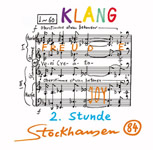|
|
 |
Dusted Reviews
Artist: Karlheinz Stockhausen Album: Freude Label: Stockhausen-Verlag Review date: Nov. 20, 2007 |

|
|
|
 |
Karlheinz Stockhausen once composed a 29-hour opera cycle, Licht, from 1977-2003. The disc under discussion here is actually the second part of a new cycle, Klang, which will encompass, more or less in real time, the 24 hours of the day.
While I have not heard Licht in anywhere near its entirety, its scope is vast on every level of instrumental deployment and cosmological plot. Klang, on the other hand, presents something almost wholly different – a journey inward. The instrumental forces are reduced here, with Freude only requiring two harpists that double as vocalists.
The 41-minute work was completed in 2005, written for the duo of Marianne Schmit and Esther Kooi. Their voices exude an heir of experienced innocence as they traverse Stockhausen’s setting of “Veni, Creator Spiritus,” the main text for Pentecost. Sometimes syllabic, often spicily sibilant and employing the speech-song associated with much of Stockhausen’s vocal writing, the setting probes the meaning of joy by exposing and distilling the complexities in that emotive state. Here again, we are presented with a moment-form, linking Freude with the frighteningly beautiful Mikrophonie II of 1965, to cite one example of deep and detailed text-setting. Twenty-four of these moments correspond, as Stockhausen notes in the accompanying essay, to the temporal parameters of his current opera cycle.
Each moment has a character, and these recur throughout as the text is stated, fragmented, whispered, swooped and lovingly harmonized in sixths, thirds, fourths and fifths, deftly evoking plainchant and early polyphony alongside more currently revolutionary vocal techniques. As with every Stockhausen composition, tiny musical motives act as signposts, sometimes thickly scattered along the serpentine path, sometimes disappearing for long stretches. An octave, a glissando, or certain vocal harmonies lend overwhelming unity to a work that thrives on diversity.
It seems unimaginable that such a piece could emerge after 26 years of work on a project that ultimately summed up Stockhausen’s multivalent compositional aesthetic. Yet, here it is. As with every volume of the Stockhausen complete edition, the recorded sound is superb, some of the finest I’ve heard. Every stroke and glide is readily apparent, even transparent when necessary, and yet the whole is pleasantly but never overly reverberant. Documentation is also top-drawer, the Stockhausen edition being one of the best-produced, mastered and recorded projects of its kind.
By Marc Medwin
|







